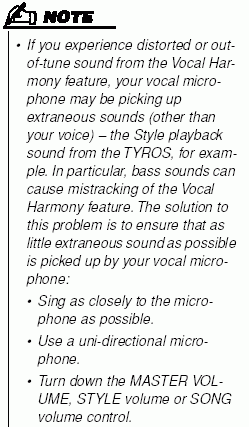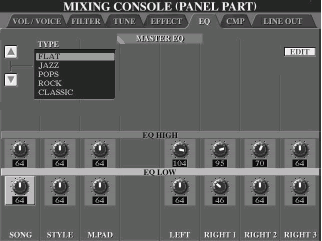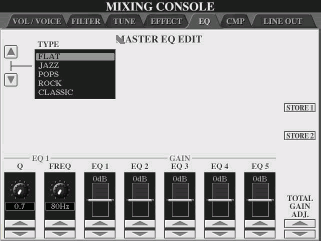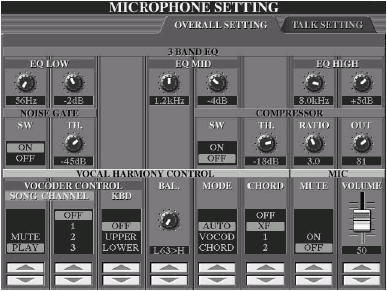Many Tyros users have experienced "distortion" when using the Vocal Harmony (VH) feature on Tyros. Personally, I have grappled with this issue for a long time and despite advice and help from many on various Forums, including Yamaha's own sponsored forum "Arranger workstation," I had almost given up, until now.
Most who have experienced this problem have focused their efforts in the area of the Microphone Equalizer (EQ), VH, and Gain/Vol settings, which would seem to be the logical area to focus on. However, it is my belief that all along it has been the keyboards Master EQ Settings that have the greatest influence on the whole VH issue.
By comparison to its predecessors, the PSR-8000 (8k) and the PSR-9000 (9k), the Tyros sounds dull and muddy using any of the Preset Master EQ settings. I had used VH on both 8k and 9k, to my satisfaction, so I was bewildered when these same settings on my new flagship Tyros seemed deficient in this area, especially since Yamaha claimed Tyros to have an improved version of the 9k VH installed.
 Anyone
who has studied the Tyros manual will see (in fine print) on page 47, the
note shown in larger print here. What this note says, in effect, is that
extraneous sounds, (other than voice) entering the Mic can cause distortion
and mistracking of the VH feature, especially Bass sounds, and
here-in lies the key to the entire problem. I had been aware of this
from the outset, and had tried reducing Bass EQs on Mic and Master EQ settings,
but without success. To make a long story short, my actions were, in fact,
the opposite to what was really required, namely to reduce Bass over the
entire EQ range by increasing high end Eqs.
Anyone
who has studied the Tyros manual will see (in fine print) on page 47, the
note shown in larger print here. What this note says, in effect, is that
extraneous sounds, (other than voice) entering the Mic can cause distortion
and mistracking of the VH feature, especially Bass sounds, and
here-in lies the key to the entire problem. I had been aware of this
from the outset, and had tried reducing Bass EQs on Mic and Master EQ settings,
but without success. To make a long story short, my actions were, in fact,
the opposite to what was really required, namely to reduce Bass over the
entire EQ range by increasing high end Eqs.
Table 1 below shows a comparison between a typical Tyros Preset EQ (PA setting), and my proposed alternatives, "Crisp" and "Medium" settings. At first glance, these settings will seem to be extreme, but not only will they eliminate VH distortion, they will also brighten up the entire voicing of your Tyros, bringing much greater clarity and crispness to every instrument/voice.
| EQ1 | EQ2 | EQ3 | EQ4 | EQ5 | |
|---|---|---|---|---|---|
| Tyros PA Preset | 0 | -3 | -1 | -2 | +1 |
| LeoD "Crisp" | +2 | +3 | +6 | +9 | +12 |
| LeoD "Medium" | +2 | +2 | +5 | +7 | +9 |
 The
screen shown here is the Master EQ tab in the MIXING CONSOLE
screen for the PANEL PART. Selecting the [MIXING CONSOLE], and make sure you are
on the PANEL PART. Keep pushing the [MIXING CONSOLE] button to cycle through all
the available parts. Use the [TAB] buttons to move over to the EQ tab.
The
screen shown here is the Master EQ tab in the MIXING CONSOLE
screen for the PANEL PART. Selecting the [MIXING CONSOLE], and make sure you are
on the PANEL PART. Keep pushing the [MIXING CONSOLE] button to cycle through all
the available parts. Use the [TAB] buttons to move over to the EQ tab.
 Pressing
the [EDIT] button brings up the MASTER EQ EDIT screen. My recommended settings
for the Microphone and vocal harmony are shown in Table 2.
Pressing
the [EDIT] button brings up the MASTER EQ EDIT screen. My recommended settings
for the Microphone and vocal harmony are shown in Table 2.
| 3 BAND EQ | |||||
| EQ LOW | EQ MID | EQ HIGH | |||
| 110 Hz | -6 dB | 1.6 kHz | +2 dB | 7.0 kHz | +8 dB |
| NOISE GATE | COMPRESSOR | ||||
SW |
TH.* -72 to -50 |
SW ** ON |
TH. -25 to -6 |
RATIO 1 to 3 |
OUT 100 to 127 |
| VOCAL HARMONY CONTROL | |||||
| VOCODER KBD | BAL. | MODE | CHORD | MUTE | VOLUME |
| LOWER | L=H | AUTO
or |
XF | OFF | 100 to 127 to suit pref. |
* Adjust to personal choice.
** Compressor "ON" increases Mic output even if RATIO is set low.
Set it to your own preference.
 The
MICROPHONE SETTING Tyros screen is shown here.
The
MICROPHONE SETTING Tyros screen is shown here.
I've also included some definitions from the manual:
NOISE GATE - This effect mutes the input signal when the input from the microphone falls below a specified level. This effectively cuts off extraneous noise, allowing the desired signal (vocal, etc.) to pass. SW (Switch) turns Noise Gate on or off. TH. (Threshold) adjusts the input level at which the gate begins to open.
COMPRESSOR - SW (Switch) turns compressor on or off. TH. (Threshold) adjusts the input level at which compression begins to be applied. RATIO adjusts the compression ratio. OUT adjusts the final output level.
| Gain control | at MIC input stage, set at approximately the mid point - 12 o'clock. |
| Mic Volume | On keyboard console above keyboard volume, set at approximately mid point - 12 o'clock. |
| Using Mic | Green signal light should show … indicating signal
present. Red signal light should not show….indicates signal overload. |
Additional Notes On Noise gate & Compression
Noisegate
The noise gate feature serves to eliminate background sounds entering the microphone. In fact, it blocks all sound below the dB level set on the threshold adjustment. At the minimum setting (-72) the noise gate feature is, practically speaking, blocking very little sound at all. However, at it's maximum setting (-30), it will virtually block all sound - including voice - entering the microphone.
A medium setting, i.e. -60 dB, could be used to reduce feedback or background noise. A setting of -30 dB means that only sound entering the mic at above -30 dB will actually get through. At this setting, you would find that speaking normally into the mic might yield no response while Vocals at power could in fact transmit OK (Pavarotti in full flight). It is for this reason that this facility must be set to your own personal preference and/or to achieve a specific or desired result.
Compression
As the word implies, compression is used to squeeze or tighten the dB range. On Yamaha keyboards it has the effect of boosting low and cutting high vocal volumes/dB. The Threshold setting ( anywhere from -45 to -6 dB ) defines at what point (dB level) the compressor begins to work. The Ratio ( variable from1 to20) represents the factor that will be applied to the sound. Simplistically, above the threshold level, 'Gain' is effectively reduced by the set ratio factor.
For example, if Threshold is set at -10 dB and Ratio is set at 5, this would mean that a 40 dB gain above -10 threshold would be reduced by a factor of 5, that is, a 40 dB gain is effectively reduced to only 8 dB. Add 8 dB to -10 dB and the effective output after compression brings output level to -2 dB.
Hopefully this is not too confusing and adds some basic understanding of these features on the Tyros and other Yamaha keyboards.
Final Note
None of the above suggested settings are cast in stone, You may need some adjustment to cater for different Microphones and personal preference, vocal timbre/strength, etc. However, the critical issue is to increase Master EQ Highs in order to reduce Bass frequencies across the entire frequency range.
-- LeoD, November, 2004
This page updated on September 20, 2024 .